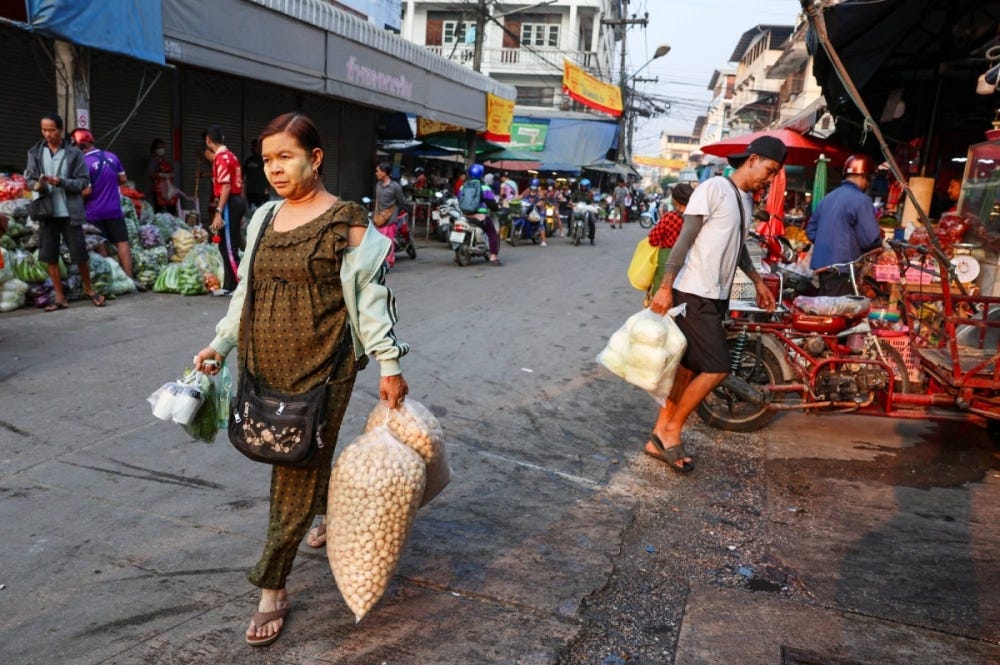Azerbaijan's Disinformation Offensive Undermines Peace with Armenia
📌 What Happened:
Following the announcement of a "peace agreement" between Armenia and Azerbaijan on March 13, 2025, the Azerbaijani Ministry of Defence initiated a disinformation campaign.
They issued multiple false reports alleging Armenian aggression along the border. This disinformation campaign appears intended to frame Armenia as the aggressor, undermining the peace process and justifying potential military actions.
⚡ The Fallout:
The disinformation has heightened tensions, eroding trust between the nations and their populations. It has led to increased scepticism about the peace agreement's viability and strained diplomatic relations.
The false narratives have also fuelled nationalist sentiments, complicating reconciliation and peace efforts. Additionally, these actions have drawn international concern, with external observers questioning the commitment of the peace process.
The spread of disinformation has also diverted attention from critical humanitarian issues, such as the plight of displaced populations, hindering efforts to provide necessary aid and support.
🔍 The Narrative Behind It:
This tactic reflects a broader strategy of using disinformation to manipulate public perception and international opinion. By portraying Armenia as the aggressor, Azerbaijan aims to gain strategic advantages and justify defensive measures. This allows some strategic shaping which may give the allowance of future kinetic operations that are “justified” by perception.
Such campaigns exploit cognitive biases, making it challenging for audiences to discern truth from falsehoods, thereby destabilizing the information environment.
Moreover, the use of state-sponsored disinformation highlights the role of information warfare in modern conflicts, where controlling the narrative can be as crucial as territorial control. This approach not only affects immediate geopolitical dynamics but also sets a precedent for future engagements. Here disinformation becomes a standard tool to achieve political and military objectives.
📝 Information Effects Statement Assessment:
The deliberate spread of disinformation by Azerbaijan's Ministry of Defence is undermining regional stability and the peace process, with high confidence based on consistent reports. Alternative explanations, such as miscommunication, are less plausible given the pattern of false allegations.
This tactic threatens diplomatic efforts and could lead to renewed conflicts.
Sources
https://www.mil.am/en/news/12674
https://www.1lurer.am/en/2025/03/16/Azerbaijani-Defense-Ministry-has-again-spread-disinformation-Armenia-s-MoD/1280311
https://www.301.am/azerbaijan-escalates-disinformation-campaign-following-alleged-peace-agreement/
Disinformation Targets Myanmar Migrants in Thailand

📌 What Happened:
Recent reports reveal that a coordinated disinformation campaign in Thailand is targeting Myanmar migrant workers. They are being portrayed as a threat to local communities through hate speech and false narratives.
The disinformation campaign targeting Myanmar migrant workers in Thailand has been notably amplified by individuals such as Nantiwat Samart, a former deputy director of Thailand's National Intelligence Agency. He has a high rate of misleading claims on social media platforms. This involvement of a prominent figure has significantly contributed to the spread of false narratives, intensifying xenophobic sentiments and justifying stricter immigration controls.
He reuploaded three images from different events, falsely alleging they were of migrant workers demanding 700 baht a day. This is approximately $21 USD, which is significantly higher than Thailand's official minimum wage of 400 baht per day.
Furthermore, AFP fact-checkers found that videos of supposed minimum wage protests were actually old and from other events. Social media platforms have been flooded with false claims about Myanmar migrant workers demanding high wages.
⚡ The Fallout:
The disinformation has intensified societal tensions, leading to increased discrimination and sporadic violence against Myanmar migrants. Local authorities and NGOs are struggling to counteract the negative impact of these false narratives on social cohesion and migrant rights.
This has led to heightened scrutiny, arrests, and deportations, further destabilizing migrant lives and threatening Thailand's economic stability.
Additionally, the spread of hate speech is complicating efforts to integrate these vulnerable communities and address underlying economic and political issues.
🔍 The Narrative Behind It:
The disinformation campaign exploits deep-seated nationalist sentiments and historical tensions between Thailand and Myanmar. This taps into modern fears about job competition and economic insecurity, deflecting attention from systemic issues in Thailand's economy.
The ongoing civil war in Myanmar has driven over a million people to seek refuge in Thailand, which some officials use to reinforce nationalistic ideologies and xenophobia. False claims, such as Myanmar workers demanding high wages, fuel fears of economic displacement among Thai workers. This coordinated effort aims to reduce Myanmar nationals' presence by portraying them as "national security threats," undermining social cohesion and threatening their crucial economic role.
📝 Information Effects Statement Assessment:
The analysis concludes that the targeted disinformation against Myanmar migrants in Thailand is significantly undermining community cohesion, with high confidence based on consistent evidence from multiple independent sources and intent of Nantiwat Samart.
While economic and political stressors also contribute to local tensions, the deliberate spread of hate speech and false narratives points to a coordinated effort with severe societal implications.
Sources
https://www.barrons.com/news/war-of-words-myanmar-migrants-face-disinformation-in-thailand-67932b8b
https://www.benarnews.org/english/news/thai/thailand-migrant-workers-hate-speech-disinformation-03042025143616.html
https://www.japantimes.co.jp/news/2025/03/17/asia-pacific/politics/myanmar-migrants-disinformation-thailand/
Russia and China's Disinformation Push: A report
📌 What Happened:
An EU report revealed that both Russia and China are ramping up disinformation campaigns against Western democracies. These state‑backed efforts leverage massive digital arsenals to shape narratives around critical events.
A discussion of “known arsenals” includes state media, private PR firms, and social media influencers that aim to generate enough of a conversation that leverages social dynamics. The tactics involve repurposing official content and disseminating it through a network of online channels, effectively manipulating public opinion.
The EU has tracked disinformation attacks against more than 80 countries and over 200 organizations in the past year.
⚡ The Fallout:
The campaigns have eroded public trust in traditional media and democratic institutions, prompting governments across the EU and the West to heighten their defences against foreign interference. As a result, policymakers are calling for increased monitoring, stricter regulations on digital platforms, and coordinated transatlantic responses.
The fallout is influencing both public discourse and strategic security policies, with immediate impacts noted in electoral processes and societal polarization.
The aim is to "destabilize our societies, damage our democracies, drive wedges between us and our partners, and undermine the EU's global standing," according to EU High Representative Kaja Kallas.
🔍 The Narrative Behind It:
This report highlights how disinformation is being weaponized as a tool of cognitive and hybrid warfare, with Russia and China using both overt state mechanisms and covert private networks to destabilize democratic societies.
The convergence of narratives between the two states underscores a broader strategy aimed at weakening Western alliances and sowing internal divisions. It reflects a fundamental shift in the global information environment where digital manipulation now plays a pivotal role in geopolitical influence.
📝 Information Effects Statement Assessment:
The coordinated disinformation efforts represent a substantial threat to Western democratic stability, with high confidence based on direct evidence from EU official communications and real-time monitoring tools.
While isolated incidents might be seen as coincidental, the systematic and cross-border nature of these campaigns suggests a deliberate strategy requiring robust countermeasures.
Sources
https://www.eeas.europa.eu/eeas/3rd-eeas-report-foreign-information-manipulation-and-interference-threats_en
https://euvsdisinfo.eu/
Flu Fatalities Spike Amid Anti-Vaccine Disinformation
📌 What Happened:
Recent data from the CDC and NFID show that the current 2024‑2025 flu season is experiencing an alarming rise in flu deaths across the U.S. This spike coincides with a surge in anti‑vaccine disinformation that has taken root online, undermining public confidence in vaccination programs.
A Washington State Standard report highlights that misleading anti‑vaccine narratives are actively discouraging people from getting their flu shots, contributing to the worsening public health crisis.
⚡ The Fallout:
The immediate consequence is an increase in flu‑related fatalities, as observed in King County and nationally, which strains public health resources and deepens community health disparities.
This disinformation has disrupted the efforts of health agencies to promote effective vaccination, leading to lower immunization rates and higher disease burden. The crisis is prompting both local and federal health authorities to intensify public health messaging and counteract misleading narratives that jeopardize community immunity.
🔍 The Narrative Behind It:
The disinformation campaign exploits existing vaccine hesitancy and amplifies fears about vaccine safety, despite robust evidence from organizations like the CDC and NFID confirming vaccine efficacy and safety.
This coordinated spread of false information is part of a broader pattern where anti‑vaccine groups leverage social media to undermine public health initiatives, ultimately eroding trust in science and governmental health advisories. The situation underscores the critical role of accurate data and proactive communication in combatting misinformation that directly threatens public health.
📝 Information Effects Statement Assessment:
The assessment concludes that the anti‑vaccine disinformation circulating online is directly linked to an increase in flu deaths, posing a serious threat to public health, with high confidence based on verified data from multiple official sources.
Alternative explanations, such as variations in the flu virus strain, are less consistent with the widespread evidence of reduced vaccination uptake due to misleading online narratives. The implications for health policy are concerning, necessitating enhanced counter-messaging and stricter oversight of digital misinformation, with key indicators including vaccination rates and flu mortality statistics.
Sources
https://www.cdc.gov/flu-burden/php/data-vis/2024-2025.html
https://www.nfid.org/infectious-disease/flu/
https://washingtonstatestandard.com/2025/03/18/flu-deaths-rise-around-u-s-as-anti-vaccine-disinformation-takes-root/
https://kingcounty.gov/en/dept/dph/about-king-county/about-public-health/news/news-archive-2025/03-07-flu-deaths
🗣️ Let’s Talk—What Are You Seeing?
📩 Reply to this email or drop a comment.
🔗 Not subscribed yet? It is only a click away.







